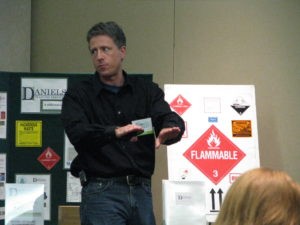Federal regulations of the U.S. Environmental Protection Agency (USEPA) require a small quantity generator of hazardous waste (SQG) to maintain equipment and processes to prevent a hazardous waste emergency and to respond to it if one occurs. The regulations are found in the following SQG conditions for exemption:
- 40 CFR 262.16(b)(8) Preparedness and prevention
- 40 CFR 262.16(b)(9) Emergency procedures
This article is the sixth in a series that closely examines and explains these regulations.
In the previous article in this series I addressed the requirements of 40 CFR 262.16(b)(8)(v) Required Aisle Space for a Small Quantity Generator
The purpose of this article: 40 CFR 262.16(b)(8)(vi) Arrangements with local authorities.
Before we begin…
These regulations were revised by the Generator Improvements Rule. If your state has not yet adopted the new rule you must continue to comply with the earlier version until it does. You may read an article explaining the earlier version of the regulations (prior to implementation of the Generator Improvements Rule) here.
After your state adopts the Generator Improvements Rule, it may choose to make its version of these regulations more stringent and more broad than these Federal regulations. The actions of your state will vary based on whether or not it has an authorized hazardous waste program. Be sure to check the regulations of your state to ensure compliance.
Scope and applicability:
The regulations addressed in this article are applicable to a SQG. The responsibility to make arrangements with local authorities for a large quantity generator of hazardous waste (LQG) are exactly the same as these but found elsewhere in the regulations (40 CFR 262, subpart M). If you are a LQG please refer to this article for your version of these regulations: The Requirements of 40 CFR 262.256 Arrangements with Local Authorities for Large Quantity Generator
Or, you may refer to the entire Preparedness, Prevention, and Emergency Response Procedures for a Large Quantity Generator of Hazardous Waste.
|
Not sure of your hazardous waste generator category? |
The placement of these regulations squarely within 40 CFR 262.16 Conditions for exemption for a small quantity generator that accumulates hazardous waste removes any doubt that these regulations apply solely to a SQG.
But where at an SQG? The entire facility? And what operations? Just those related to hazardous waste management? In the preamble to the final rule in the Federal Register, USEPA stated its primary objective was to ensure these regulations do not apply to the entire facility (November 28, 2016, FR 81, 85792). However, USEPA did clarify that these regulations – and all preparedness, prevention, and emergency response procedures of both SQG and LQG – are applicable to all areas of a facility where hazardous waste is:
- Generated. This means all points of generation.
- Accumulated. This includes both central accumulation area(s) (CAA) and satellite accumulation area(s) (SAA).
- Those areas where allowable treatment of hazardous waste may occur in accumulation units (November 28, 2016, FR 81, 85792).
All satellite accumulation areas operated by a small quantity generator must meet the preparedness and prevention regulations of §262.16(b)(8) and emergency procedures of §262.16(b)(9). Prior to the Generator Improvements Rule agency guidance and enforcement limited the applicability of these regulations solely to hazardous waste in the CAA and did not include the SAA. To clarify its position in the preamble, USEPA also added the following to the revised regulations for SAAs at §262.15(a)(7):
All satellite accumulation areas operated by a small quantity generator must meet the preparedness and prevention regulations of §262.16(b)(8) and emergency procedures of §262.16(b)(9).
40 CFR 262.16(b)(8)(vi) reads:
(vi) Arrangements with local authorities. (A) The small quantity generator must attempt to make arrangements with the local police department, fire department, other emergency response teams, emergency response contractors, equipment suppliers and local hospitals, taking into account the types and quantities of hazardous wastes handled at the facility. Arrangements may be made with the Local Emergency Planning Committee, if it is determined to be the appropriate organization with which to make arrangements.
(1) A small quantity generator attempting to make arrangements with its local fire department must determine the potential need for the services of the local police department, other emergency response teams, emergency response contractors, equipment suppliers and local hospitals.
(2) As part of this coordination, the small quantity generator shall attempt to make arrangements, as necessary, to familiarize the above organizations with the layout of the facility, the properties of hazardous waste handled at the facility and associated hazards, places where facility personnel would normally be working, entrances to roads inside the facility, and possible evacuation routes as well as the types of injuries or illnesses that could result from fires, explosions, or releases at the facility.
(3) Where more than one police or fire department might respond to an emergency, the small quantity generator shall attempt to make arrangements designating primary emergency authority to a specific fire or police department, and arrangements with any others to provide support to the primary emergency authority.
(B) A small quantity generator shall maintain records documenting the arrangements with the local fire department as well as any other organization necessary to respond to an emergency. This documentation must include documentation in the operating record that either confirms such arrangements actively exist or, in cases where no arrangements exist, confirms that attempts to make such arrangements were made.
(C) A facility possessing 24-hour response capabilities may seek a waiver from the authority having jurisdiction (AHJ) over the fire code within the facility’s state or locality as far as needing to make arrangements with the local fire department as well as any other organization necessary to respond to an emergency, provided that the waiver is documented in the operating record.
Why the change?
The RCRA generator regulations were finalized in 1980 and have not been updated, prior to the Generator Improvements Rule, to reflect significant changes to national, state, and local infrastructure for emergency planning and response. One significant change was the passage of the Emergency Planning and Community Right-to-Know Act (EPCRA) in 1986 which resulted in the creation of Local Emergency Planning Committees (LEPCs) and other reporting responsibilities for many hazardous waste generators.
|
Interested in site specific training at your site that covers this topic, and more! Ask me about my Onsite Training |
“Attempt to make Arrangements…”
A revision to the language of the regulations at §262.16(b)(8)(vi)(A) but not a significant change in requirements. First of all, the generator must “attempt” to make the arrangements with the local authorities indicated (see below); this does not require an arrangement agreed to by all parties.
And what is meant by “arrangement”? Though not defined, it is clear given the context of the regulations and the parties involved the intent is to have an arrangement for emergency services at your facility when necessary. What form these arrangements take is not specified, though the SQG may take into account the type and quantity of hazardous waste it handles at its facility. For example, arrangements with equipment suppliers may be limited or non-existent if there is no need for equipment during a hazardous waste emergency at your facility. Later in these regulations, and this article, the arrangements are further explained.
Local authorities to attempt to make arrangements with are identified as:
- Local police department
- Local fire department
- Other emergency response teams
- Emergency response contractors
- Equipment suppliers
- Local hospitals
- Local Fire Department
- Local Police Department
- Local Hospital
And…
- LEPC if it is determined to be the appropriate organization with which to make arrangements.
The inclusion of the LEPC as an option in addition to the local authorities was a revision of the Generator Improvements Rule. It is important to read the regulatory language, “Arrangements may be made with Local Emergency Planning Committee,…” to understand it is an option for the SQG to make these arrangements with the LEPC in addition to the local authorities identified if the LEPC is determined to be the appropriate organization with which to make arrangements. This determination can only be made by the SQG. So, if there exists an active LEPC in your area, I strongly advise you to attempt to make arrangements with them.
|
Contact me with any questions you may have about the generation, identification, management, and disposal of hazardous waste Daniels Training Services, Inc. 815.821.1550 |
“Must determine the potential need…”
Text was added to these regulations at §262.16(b)(8)(vi)(A)(1) to require an SQG making arrangements with its local fire department to also determine the potential need for the services of the following:
- Local police department
- Other emergency response teams
- Emergency response contractors
- Equipment suppliers
- Local hospitals
I can find no reference to the regulations of this paragraph or an explanation of its purpose. It seems to me that USEPA wants to ensure the SQG considers its need for emergency response and what can be provided by local authorities. Notably absent from this list is the LEPC since it typically is not involved in actual responses to emergencies.
“As part of this coordination…”
At §262.16(b)(8)(vi)(A)(2) we get to the main purpose of these regulations, and that is for the SQG to attempt to familiarize the local authorities it has contacted with specific information at its facility that those authorities will find useful in an emergency. Information you must provide to local authorities includes:
- Layout of facility.
- Properties of hazardous waste handled at the facility and associated hazards.
- Places where facility personnel would normally be working.
- Entrances to roads inside the facility.
- Possible evacuation routes.
- Types of injuries or illnesses that could result from fires, explosions, or releases at the facility.
How you attempt to familiarize the local authorities with this information is not specified. Options include:
- Provide the required information as a separate document.
- Invite local authorities to your facility to see for themselves.
- Meet this requirement through other emergency preparedness reporting to local authorities, such as the Tier II Report required by EPCRA.
- Some combination of the above.
“More than one police or fire department…”
The regulations of §262.16(b)(8)(vi)(A)(3) are not new. They require three things of the SQG:
- Determine if more than one police or fire department has jurisdiction over your area (e.g., both city and county) and might respond to an emergency at your facility.
- Attempt to communicate with all parties to designate primary emergency authority to a specific fire or police department.
- Attempt to make arrangements with any others to provide support to the primary emergency authority. e.g., emergency response contractors and equipment suppliers.
“…Shall Maintain Records…”

Be sure to maintain records of all attempts – successful or not – to make arrangements with local authorities
A minor change in the text but a significant change in the responsibilities of a SQG at §262.16(b)(8)(vi)(B). Unlike the earlier version of the regulations which only required the documentation in the operating record of a failure to make arrangements with local authorities, the regulations revised by the Generator Improvements Rule now require the SQG to maintain records documenting either that such arrangements actively exist or confirm that attempts to make arrangements were made but no such arrangements exist.
But what constitutes sufficient documentation? First of all, USEPA acknowledges that the documentation may take many forms:
There are various means of confirming that arrangements actively exist, or were sought but not obtained, including, but by no means limited to, a certified letter, fax and electronic mail.”
The regulations require any documentation (certified letter, fax, email, &etc.) be made in the operating record, which includes, but is not limited to, the contingency plan (required of an LQG) or can be some other facility records. Just make sure you keep the records for as long as they accurately reflect the arrangements at your facility and for at least three years thereafter.
How ’bout a waiver?
Another significant change from the regulations prior to the Generator Improvements Rule. §262.16(b)(8)(vi)(C) allows for a SQG to obtain a waiver from all requirements to make arrangements with local authorities under the following conditions.
- The facility must possess 24-hour response capabilities.
- It must seek a waiver from the authority having jurisdiction (AHJ) over the fire code of its jurisdiction.
- The AHJ must evaluate the facility to determine if it does, in fact, possess 24-hour response capabilities.
- The AHJ may then grant a waiver from the requirement to attempt to make arrangements with the local fire department as well as any other emergency response organization.
- This waiver must be kept as a record by the SQG in its operating record. Similar to the requirement to maintain records of the attempts to make arrangements with local authorities – whether successful or not – earlier in this article, USEPA does not specify what form the record of the waiver takes.
|
Contact me the next time hazardous waste generator USEPA training is due to expire. |
Is that it?
No. First of all, as an SQG you must still comply with the remaining requirements of §262.16(b)(8) for preparedness and prevention and the emergency procedures of §262.16(b)(9). You may view all of those regulations here.
Use this sample letter as a template when you seek to comply with these regulations by contacting local authorities.

And then, what about training? At §262.16(b)(9)(iii) and therefore part of the SQG’s emergency procedures, it mandates the SQG ensure that all employees are thoroughly familiar with proper waste handling and emergency procedures…While not calling for documented training, clearly some form of instruction or information must be presented to hazardous waste personnel of a SQG.



